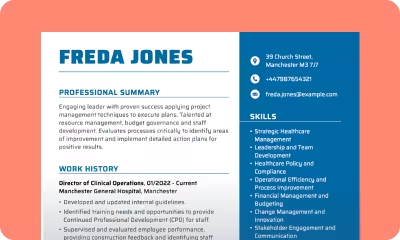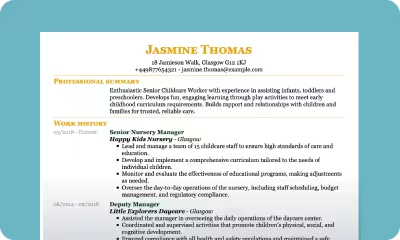- Our customers have been hired by : *Foot Note
The first step to becoming an occupational therapist is to complete a thorough application, made easier with a CV templates. A professional-looking CV filled with relevant information, in a format that’s easy to read, gives potential employers a good first impression and makes it more likely that they will take your application further.
Modelling your own application on an occupational therapist CV sample can help ensure you include all the necessary details, list your qualifications and skills in a logical order, and format your CV correctly, so the facts stand out at a glance.
Use the occupational therapist CV sample below as a template to create a CV that stands out, and gets you started on your way to your new role. We’ve combined occupational therapy CV examples (UK) with in-depth advice on each section to simplify the process.
Find out how to write a CV for an occupational therapist, including:
SEARCH ALL CV EXAMPLES
Occupational therapist CV sample
Angela Lombardo
82 Boleyn Road, London N1 2JG
07912345678
Angela.Lombardo@example.co.uk
Professional summary
Proficient team player skilled in promoting improvements to physical strength and abilities to enhance patient life at home, school or workplace. Strong planning, problem-solving and relationship-building skills.
Work history
June 2018 – Current
Sunnybank Care Home – London
Occupational Therapist
- Provided high quality assessment and treatment programmes in line with patient needs and strengths, enabling a swift recovery.
- Reduced process lags by efficiently educating new employees on facility protocols and operational best practices.
- Continually measured treatment progress against care plan objectives by accurately recording all pertinent information regarding treatment programmes.
January 2016 – May 2018
South London and NHS Foundation Trust – London
Occupational Therapy Assistant
- Upheld strict confidentiality standards and worked with discretion at all times.
- Maintained complete, accurate reports and documented changes in service users’ physical or mental health, escalating concerns to the manager.
- Facilitated positive treatment outcome for patients with complex health needs by issuing referrals to specialist providers.
Skills
- Patient-centred care
- Mental Capacity Act knowledge
- Exercise physiology
- Therapeutic interventions
- Excellent time management
- Case management
- Treatment planning
- Patient and family education
Education
London University London – 2017
Bachelor of Science Occupational Therapy
Occupational therapist CV format
CV formats assist you in laying out information clearly and succinctly. There are two primary structures to choose from – the reverse-chronological CV or the skills-based CV. The former highlights your tangible experience, while the latter sells your potential.
Occupational therapy is a health and social care profession regulated by the Health and Care Professions Council (HCPC). As such, you need to prioritise your work experience, qualifications and training. Choose a reverse-chronological CV format that lists your professional history, starting from your most recent position. Sections should include:
- Contact details
- Compelling personal summary
- Core qualifications to quickly prove your suitability – list three to four bullet points
- Work experience in reverse-chronological order
- Education and training
- Other interests that demonstrate sought-after qualities – you might volunteer at a shelter on the weekends or lend your skills to a charity
Skills-based CVs aren’t typically appropriate for occupational therapists because you must prove you have the relevant credentials. Employers, including the NHS, want to see that you’re degree-educated, knowledgeable and involved in annual Continuing Professional Development (CPD).
In addition to a proven track record, the best occupational therapy CV examples (UK) demonstrate personal attributes like kindness and empathy. Include examples of how you guide patients towards better wellbeing through compassionate, research-based strategies.
Occupational therapist CV tips
Focus on hard skills
Occupational therapy demands a unique set of hard skills, like medical, anatomical and neurological knowledge. Employers prefer candidates with an established track record in health and social care settings. They also require proof that you’re a member of the relevant governing bodies.
Don’t skip over education
Formal qualifications are necessary for occupational therapists because much of the work is science-led and research-heavy. Employers expect you to keep up to date with best practices, so remember to note ongoing learning and development training in the education section.
Provide real-life examples
Diving into real-life examples can demonstrate a caring and nurturing disposition. If appropriate, explain how you’ve helped your patients lead more fulfilling lives. You can then back this up with recovery statistics. You might have devised a treatment plan that improved anxiety levels by 67% or helped someone regain their mobility within three months.
Tailor your CV to the job specified
Occupational therapy has countless specialisms, each requiring a different skill set. You can make your CV stand out in a sea of applications by keeping the information relevant to the advertised job. Read the specification and identify key criteria, then use that to guide the writing process.
Pair your occupational therapist CV with a cover letter
Many candidates get stuck on how to write a cover letter, but it doesn’t have to be complicated. Think about it as an less formal introduction that presents your achievements in the best light possible. You only have to include a few paragraphs, and remember to use vocabulary appropriate for the profession.
As a rule, break your cover letter into:
- Three to four sentences stating the purpose of your letter
- Nine to twelve sentences listing your accomplishments
- Three to four sentences explaining why you’re best for the role
If you’re struggling to find the right words, reread the job specification. Employers will list the attributes they’re looking for – reflect these back to them in your cover letter.
How to write a CV for an Occupational Therapist
Time to move on to practice. Below we will show you how to write your Occupational Therapist CV step-by-step in a simple way. Follow our advice and you’re sure to create a great CV that meets all the standards.
You will learn about:
- Adding contact details to your occupational therapist CV
- How to write a personal statement for your occupational therapist CV
- Occupational therapist CV work experience
- Top skills for your occupational therapist CV
- Occupational therapist CV education
Adding contact details to your occupational therapist CV
Healthcare organisations are extremely busy, so providing accurate contact details is essential. Easy-to-find information allows employers to reach you without searching for the original correspondence. Include:
- Full name
- Email address – avoid unprofessional email addresses
- Phone Number
- Location or address
Example of contact section for a catering manager CV
Freda Smith
12 West Street
Brixton, SE24 6HS
07777 123 456
freda.smith@hopmail.com
How to write a personal statement for your occupational therapist CV
A personal statement is the first thing an employer reads when they receive your application. If it doesn’t capture their interest or showcase relevant abilities and experience, you might lose your opportunity. Despite only being three to four sentences long, it’s a critical first impression that sets you apart from other candidates. The more confident you sound, the better!
Writing about yourself can be tricky, but follow these tips and you’ll be on the right track:
- Use the third person to sound more professional
- Mention how many years you’ve worked as an occupational therapist
- Include real-world examples and numbers, like how many clients you can manage per caseload
- Keep it concise – the maximum length is around 100 words
Example of personal statement for an occupational therapist CV
Hard-working professional experienced in delivering occupational therapy to clients of varying ages and needs. Studied BSc in Occupational Therapy at London University. This three-year course included a placement at London River Hospital. After graduating, worked on the South London NHS Trust’s rotation scheme.
OR
Occupational therapist specialised in working with older people in a care home setting since 2013, a role that covers a wide range of conditions. Experienced in liaising with both other health professionals and clients’ families. Keep up to date with the best practices and new developments in the field. Currently seeking a role with greater responsibility as part of a larger OT team.
Occupational therapist CV work experience
The work experience section of your CV proves why you’re the best person for the job. Spend time outlining your achievements within each role, and back them up with figures and results. For instance, what sounds better?
“Responsible for many patients.”
OR
“Successfully managed a caseload of 25 patients, providing tailored care to help them meet their goals.”
Your work history should be specific to the position you’re applying for. Perhaps you’re moving into a specialised field that provides end-of-life care. Can you demonstrate relevant experience within a hospital setting? If you’d like to become an occupational therapist for children with additional needs, emphasise the times you’ve worked in schools.
When you read through occupational therapy CV examples (UK), you’ll notice the work history section has a particular format. List your employment in reverse-chronological order, starting from your most recent or current position. Include:
- Job title
- Place of employment
- Dates of employment
- Brief summary of responsibilities
You also can talk about occupational therapy volunteer work here. Giving your time to charities demonstrates a generous nature. Plus, it shows that you care about the needs of the local community.
Example of work experience for an occupational therapist CV
Rotational Occupational Therapist, South London NHS Trust (2012 – 2013)
- 12-month rotational post at South London Hospital, including palliative care, mental health, and wheelchair services.
- Visiting clients in their homes and places of work, as well as in a hospital setting.
Occupational Therapist, Sunnybank Care Home (2013 – present)
- Specialising in gerontology, covering stroke rehabilitation, long-term conditions and mental health issues, as well as rehabilitation after operations, illness, or injury.
- Acting as a liaison between families, care home staff, and health professionals. Carrying out functional assessments and designing solutions.
Top skills for your occupational therapist CV
A persuasive CV skills section contains a mixture of soft and hard skills. Soft skills are transferable and reflect your personality. For example, you might describe yourself as “detail-oriented”, “motivated” and “flexible”. In contrast, hard skills are often more technical and job-specific.
Your occupational therapist CV needs a combination of both. Here are some must-haves and desirables to include:
Essential skills for occupational therapists
- Occupational therapy or apprenticeship degree
- Good knowledge of medical software
- Registered with the Health and Care Professions Council (HCPC)
- British Association of Occupational Therapists (BAOT) member
- Experience working within a multidisciplinary team
- Full driving licence as care is often given at a patient’s home
Desirable aptitudes to set you apart
- Interesting in building relationships with people
- Excellent communication skills
- Patience under stressful conditions
- Time management
- Problem-solving capabilities
Occupational therapist CV education
The path to becoming an occupational therapist is long and for good reason. You’ll be responsible for the most vulnerable people’s care, building their confidence through medically sound treatment plans. You must substantiate your capabilities through a comprehensive education.
The entry requirements include a degree in occupational therapy, which usually takes three years to complete full-time or six years part-time. Alternatively, you can gain an occupational therapy degree through an apprenticeship. Here, you’ll work for an employing organisation, like the NHS or local authority, splitting your time between paid work (80%) and a classroom environment (20%). This route is perfect for people who enjoy hands-on, practical learning.
Once you’ve completed your studies, you have to register with the Health and Care Professions Council before you can start practising. Generally, it’s a good idea to reiterate membership to accrediting bodies in the skills section above.
When listing education and additional qualifications, include:
- School, college or university name
- Study and graduation dates
- Qualification level – GSCE, BTEC, diploma
- Qualification result
- Subject or course title
Example education section for an occupational therapist
London University, 2006 BSc in Occupational Therapy (2:1)
Brixton High School, 2002 A Levels in English (A), French (B), and Biology (B)
Brixton High School, 2000 6 GCSEs in grades A-C, including English, Mathematics and Biology
Your occupational therapist CV questions answered
How do I write a CV for an occupational therapist?
The easiest way to write a CV is by using occupational therapy CV examples (UK) for inspiration. Consider how the duties and responsibilities match your own career and go from there. You can also check the job description for good competencies and experience to include.
What are the responsibilities of an occupational therapist?
Occupational therapy is a varied role and every day looks different. Your responsibilities depend on your speciality – some therapists work with children in schools, while others help people recover in rehabilitation centres. With that said, general duties include:
- Planning, implementing and assessing treatment plans
- Liaising with doctors, nutritionists and social workers
- Keeping records of patient progress for case meetings
- Referring patients to other specialist units
- Organising support groups for carers and clients
What skills should an occupational therapist have?
Most importantly, occupational therapists must have a genuine interest in people. They deliver high-quality care 24/7, supporting their patients with everyday tasks like dressing, preparing meals and going to work. Problem-solving under pressure is paramount – people’s lives may depend on it. Employers look out for:
- Exceptional communication skills
- Physical Strength – you may need to support patients moving from A to B
- Nurturing and compassionate nature
- High level of organisation to manage multiple clients
How do you put fieldwork on a CV?
Fieldwork includes work placements or internships completed before or during your employment. You can talk about both in the work history section of your CV.
Create a winning occupational therapist CV today
Want to start your career as an occupational therapist? This occupational therapist CV sample is just a part of the resources available on our website. Explore our tools and CV builder for further help and advice.
Check out our fantastic CV examples and browse our selection of pre-made CV templates. Our online builder makes the whole process stress-free, thanks to handy pre-written content and drag-and-drop functionality
*The names and logos of the companies referred to above are all trademarks of their respective holders. Unless specifically stated otherwise, such references are not intended to imply any affiliation or association with myperfectCV.




